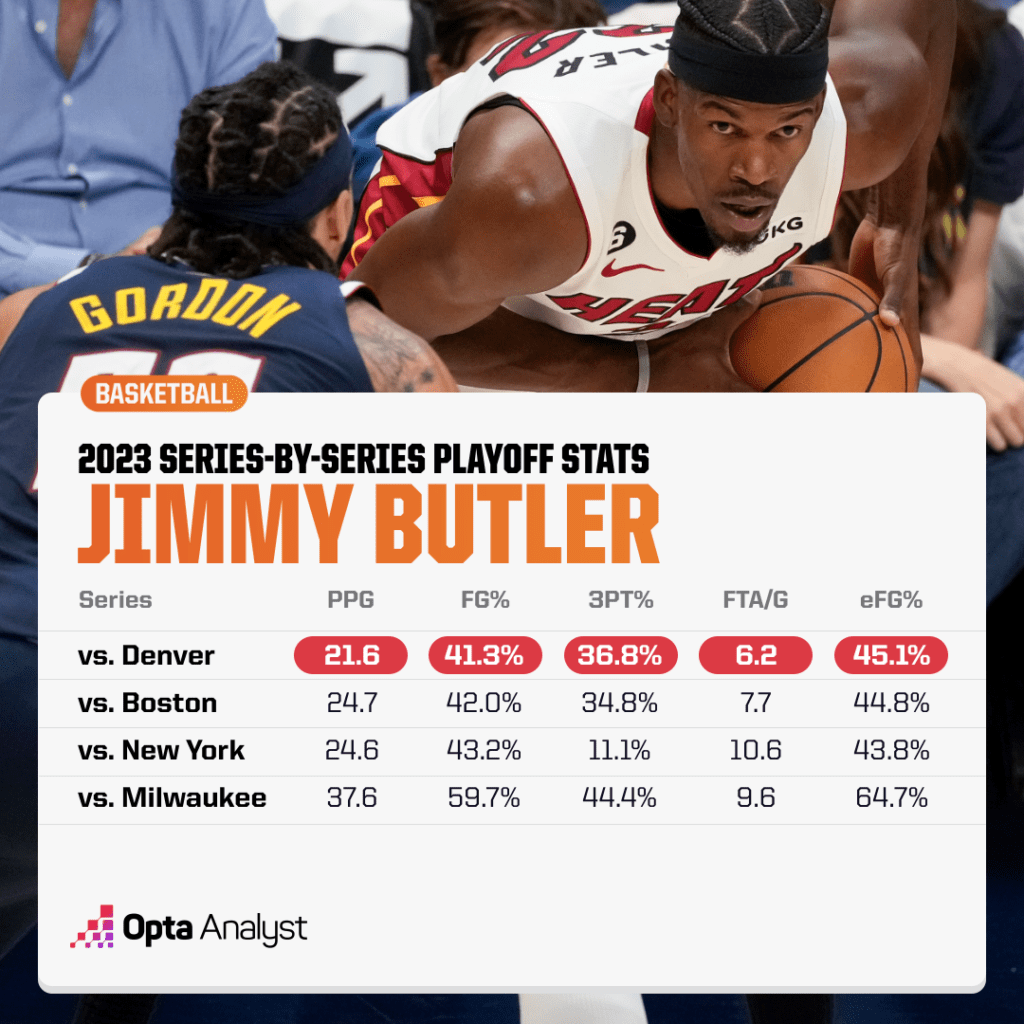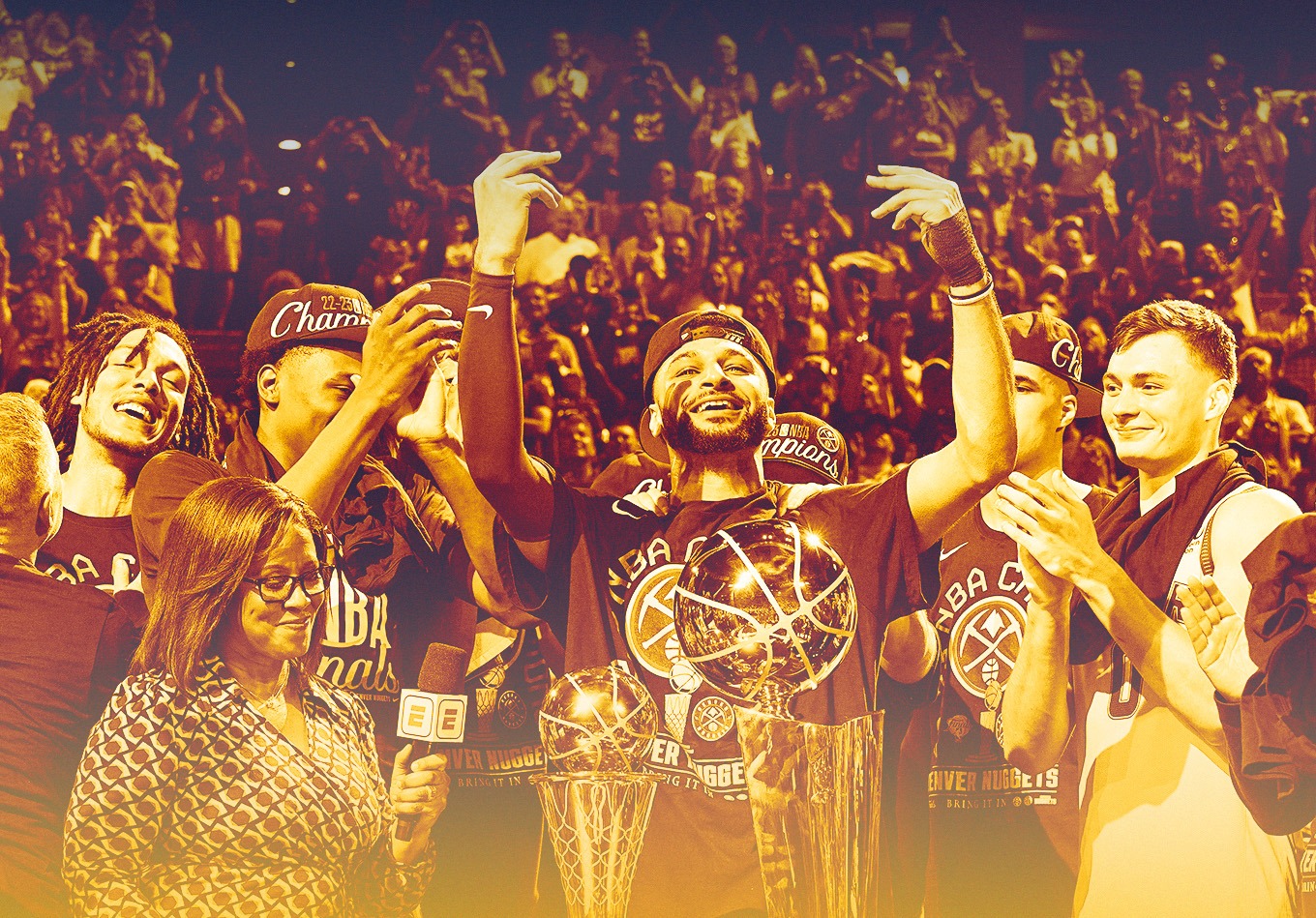After one final grind-it-out win against the Miami Heat on Monday night, the Denver Nuggets are NBA champions for the first time in franchise history.
The Nuggets never trailed in a playoff series at any time during the postseason, going 16-4 overall. How did they manage to steamroll the competition in such impressive fashion?
Let’s take a look and find out.
Embracing Their Greatest Weakness
Heading into the second season, the biggest question surrounding the Nuggets’ ability to win their first NBA title was their defense, namely their ability to protect the paint (the most important part of defense).
During the regular season, Denver ranked 26th in the NBA in opponent points in the paint per 100 possessions, allowing 53 points per 100 (per NBA.com). The big reason for this is that the Nuggets didn’t roster many great individual rim protectors.
A solid proxy for rim protection is block percentage (BLK%). In the regular season, the Nuggets didn’t have a single player in the top 40 in this statistic. By this measure, their best rim protector was Aaron Gordon, who ranked 45th in the association with a BLK% of 2.2.
Knowing that no lone anchor existed on its roster, Denver decided that the paint would need to be safeguarded by committee. To do this, head coach Michael Malone instructed off-ball defenders to sag off their man and sink into the paint.
As the montage below demonstrates, the Nuggets did something similar to this in every round of the playoffs:
In the playoffs, the Nuggets went from conceding 53 points in the paint per 100 to just 48.3 points. That total still only gave them the ninth-lowest average of the 16 teams that participated in the playoffs, but it was just enough of an edge to let their offense do the rest.
As we’ve discussed before, the Nuggets did all they could to keep center Nikola Jokić in a deep drop as much as possible. That allowed him to stay close to the paint. And while he’s often been cited as a poor rim protector, he’s been excellent in that regard during the playoffs.
He defended an average of 8.6 shots inside of 6 feet and held opponents to a field goal percentage that was 10% less than expected.
Gordon, Jokić, Michael Porter Jr., Kentavious Caldwell-Pope and Co. also played a key role in the Nuggets holding Eastern Conference finals MVP Jimmy Butler to a quiet 21.6 points on 41.3% shooting in the NBA Finals.
Remarkably, he only shot a total of 31 free throws in the five games.

Playing Fast and Being Big
The whole ideology behind the 7-Seconds-or-Less Phoenix Suns was that by playing fast, you gain access to the most efficient shots possible (because, theoretically, the best looks come early in the shot clock). This year, the Sacramento Kings took this approach to a whole other level with the breakneck pace they played at.
The Nuggets also have some mid-2000s Suns flowing through their veins, and they channeled that ancestry during their playoff run. In the postseason, the Nuggets had the sixth-highest frequency (14.8%) and third-highest efficiency (58.5% effective field goal percentage) on shots taken with between 22-18 seconds left on the shot clock.
Their synergistic, multi-layered halfcourt offensive machine made it so that Denver wouldn’t always need to rely on its speed. However, when teams could figure out how to slow down the juggernaut, the Nuggets could rely on their pace pushing to keep them afloat.
In the Nuggets’ win in Game 5 of the NBA Finals at Ball Arena, they needed this resource to claim the Larry O’Brien Trophy.
To their credit, the Heat did a good job of mucking up Denver’s offensive rhythm. So, to counter their stoutness, the Nuggets were diligent about attacking early in the clock before the Miami defense could get set.
Way back when we first previewed the 2022-23 NBA season, one of our major fascinations revolved around the gigantic Orlando Magic. That’s because size (when it is functional/versatile) rules the day in basketball.
Turning this back to the Finals, one of the massive takeaways after Game 1 was just how much bigger the Nuggets were than the Heat. This disparity was most obvious when observing all the issues Gordon gave the Heat. His combination of functional and versatile size enabled him to mismatch-hunt smaller Heat players and bully them inside.
His tantalizing skill set proved to be an immensely valuable bow in the Nuggets’ playoff quiver in earlier rounds too. Against the Minnesota Timberwolves in the first round, his ability to perform various two-man maneuvers with Jokić (first clip in the montage below) while also standing tall against bigger defenders (second clip) presented Rudy Gobert and Karl-Anthony Towns with a gluttony of problems.
Against the Phoenix Suns in the second round, he rag-dolled Kevin Durant with his brute force on offense (third clip) and turned into Durant’s own personal human blanket on defense (fourth clip).
[Sidebar: According to NBA.com’s matchup data, Gordon held Towns to 10-of-27 shooting (37%) and Durant to 26-of-68 shooting (38.2%) when he defended them during the playoffs.]
And although Gordon struggled for much of Denver’s series against the Los Angeles Lakers in the Western Conference finals, he even found a way to break free in Game 4 to close out that series.
The New-Age Shaq and Kobe
Ever since everyone’s favorite dynamic duo split up in 2004, the NBA world has been anxiously awaiting the next iteration of Shaquille O’Neal and Kobe Bryant. And while many worthy torchbearers have risen through the ranks, none seem to match the mold as well as Jokić and his partner-in-crime Jamal Murray.
The Joker, who had two triple-doubles on the way to earning NBA Finals MVP honors, is the modern-day inevitable offensive force that O’Neal was in the early 2000s. He’s the best offensive player on the planet, and it may not even be close. On the flip side, Murray has inherited Bryant’s tough shot-making and penchant for the big moment.
Together, the two have terrorized the 2023 playoffs. They are both in the 88th percentile or higher in scoring (measured by points per 100 possessions) and playmaking volume (assists per 100 possessions). And they both landed in the 68th percentile or higher in scoring efficiency (true shooting).
We’ve covered how the Jokić/Murray two-man team has a counter for every basic type of coverage ad nauseum. Well, in Game 5, Murray showed that he even has a workaround for the more nuanced strategy Miami started deploying in Game 3 (the “hard show”).
Miami started mixing in more “hard shows” with the “soft shows” it had been throwing at Murray early in the series. In this clip, we see the Heat aggressively trap the point guard Murray and then send a third defender at the Serbian superstar Jokić (effectively eliminating the pick-and-pop option).
And what does Murray do in response? Calmly survey the terrain before darting a beautiful dish to Gordon under the rim.
And while the play-by-play analog will credit Bruce Brown with helping the Nuggets reclaim the lead one last time with his putback to give them a 90-89 lead, it was actually Murray/Jokić’s combined gravity that created the opportunity.
We mentioned Miami resorting to more nuanced tactics. One of those coverage wrinkles required the Heat to initially “show” on the screen, only to turn it into a late switch.
That’s what Caleb Martin and Bam Adebayo did in the play above. This neutralized their action, but it left Adebayo out on the perimeter guarding Murray instead of near the paint crashing the glass.
So, when Murray hoisted up his off-the-dribble jumper, two smaller Heat players had to box out Gordon (goes back to the size discrepancy). And as a result, no one was around to put a body on Brown, who was able to sneak right in for the final lead change of the season.
Coming into the playoffs, our NBA playoff projection model gave the Nuggets just the sixth-highest odds (6.8%) of winning the title. The model feared that their lackluster defense (16th in adjusted defensive rating) might hinder their chances of reaching the promised land.
But through effort and wise tactical adjustments, Denver was able to quell those fears. By the end of the playoffs, the Nuggets moved all the way up to 10th in our final adjusted defensive ratings with the third-largest improvement since the start of the postseason behind the Heat and New York Knicks.
With that settled, the team was able to lean on its functional and versatile size, ability to play with pace, and unstoppable two-headed monster. It sent Nuggets fans pouring into downtown Denver to celebrate the franchise’s first NBA championship.
And for all the Nuggets’ triumphs and tribulations during this march, they’ve also earned the ultimate achievement: basketball immortality.
Enjoy this? Follow us on Twitter.
